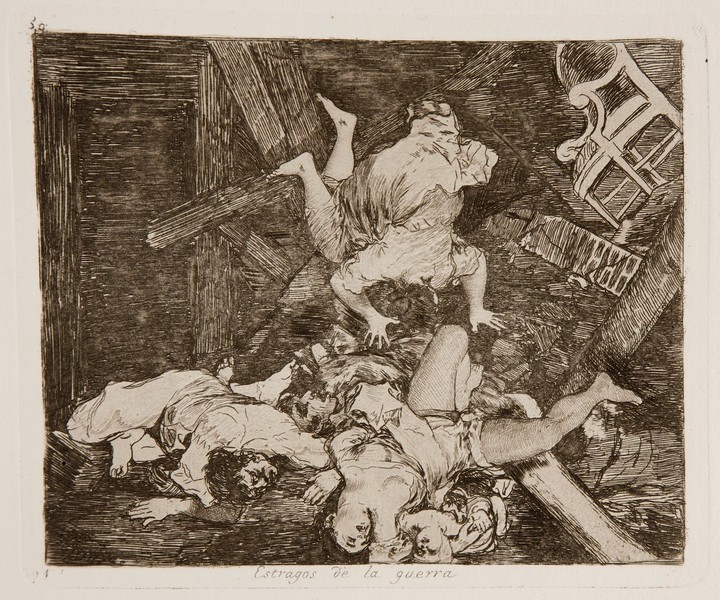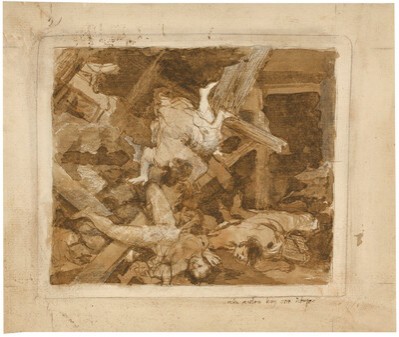- Cronología
- Ca. 1810 - 1812
- Dimensiones
- 141 x 170 mm
- Técnica y soporte
- Etching, burin, drypoint and burnisher
- Reconocimiento de la autoría de Goya
- Undisputed work
- Ficha: realización/revisión
- 06 Dec 2010 / 02 Jun 2023
- Inventario
- 225
Goya (lower left-hand corner), 21 (lower left-hand corner).
See Sad presentiments of what must come to pass.
The first artist's proof shows how the face, chest and legs of the woman in the foreground were worked in drypoint, as were the arms of the woman who is falling and another woman on the left-hand side of the composition. The shadow of the beam below the right thigh of the woman in the foreground was rendered with burin, reinforcing the broken etched lines in the background and the head of the falling female figure.
There is an artist's proof that is housed in the Museum of Fine Arts in Boston which belonged to Infante Sebastian.
The title was handwritten on the print by Goya in the first and only series that is known to have been printed at the time the works were created, which the artist gave to his friend Agustín Ceán Bermúdez. Therefore, the title was etched into the plate at a later date and left unchanged as of the first edition of the Disasters of War printed by the San Fernando Royal Academy of Fine Arts in Madrid in 1863, after the printing of the series in the possession of Ceán Bermúdez.
There is a surviving preparatory drawing for this print which is housed in the Prado Museum in Madrid.
In this print Goya depicts the effects of a bombardment on the interior of a house. His inspiration possibly came from one of the bombardments which took place during the first siege of Zaragoza that he would have known about, although this kind of event would have been common during the war.
Within the house everything has been destroyed by the explosion: the roof beams are falling down, the furniture is in disarray, and there are bodies piled up on the floor, as well as one figure that seems to be thrown forward by the blast.
Goya creates a dark space in this print, perhaps in order to denote that the scene takes place at night, surprising the inhabitants of the house in their nightshirts. This darkness is expressed through the heavy use of etching in dense horizontal lines while the artist employs areas of white for the bodies left by the explosion. The violent postures of the corpses, the expressions of horror on the open-mouthed faces and the chaos inside the room generate a devastating atmosphere.
This print must be related to another catastrophic scene from the Disasters of War series, nº 41, They Escape Through the Flames (Escapan entre llamas). It is also clearly reminiscent of other previous Goya works, such as the two depicting fires, The Fire at Night and Fire in a Hospital, in which the protagonists have also been surprised in the night and flee in terror in their nightshirts. In all of these works Goya deals with catastrophe and its sublime capacity to block our senses and stop reason from operating.
The plate is stored in the National Chalcography (cat. 281)
-
De grafiek van GoyaRijksmuseum RijksprentenkabinetAmsterdam1970from November 13th 1970 to January 17th 1971cat. 72
-
Goya. Das Zeitalter der Revolucionen. Kunst um 1800 (1980 – 1981)Hamburger KunsthalleHamburg1980cat. 84
-
Francisco de GoyaMuseo d'Arte ModernaLugano1996exhibition celebrated from September 22nd to November 17th.cat. 30
-
Francisco Goya. Sein leben im spiegel der graphik. Fuendetodos 1746-1828 Bordeaux. 1746-1996Galerie KornfeldBern1996from November 21st 1996 to January 1997cat. 116
-
Ydioma universal: Goya en la Biblioteca NacionalBiblioteca NacionalMadrid1996from September 19th to December 15th 1996cat. 199
-
Goya's RealismStatens Museum for KunstCopenhagen2000from February 11th to May 7th 2000cat. 41
-
Goya. Opera graficaPinacoteca del Castello di San GiorgioLegnano2006exhibition celebrated from December 16th 2006 to April 1st 2007p. 66
-
Goya en tiempos de guerraMuseo Nacional del PradoMadrid2008consultant editor Manuela B. Mena Marqués, from April 14th to July 13th 2008cat. 90
-
Goya et la modernitéPinacothèque de ParisParís2013from October 11st 2013 to March 16th 2014cat. 69
-
Madrid2017
-
2022
-
Goya, grabadorMadridBlass S.A.1918cat. 132
-
Goya engravings and lithographs, vol. I y II.OxfordBruno Cassirer1964cat. 150
-
Vie et ouvre de Francisco de GoyaParísOffice du livre1970cat. 1044
-
Vicisitudes de algunas láminas grabadas por Francisco de Goya: Los desastres de la guerra, Los disparates, La tauromaquiaGoya1978-1979p. 288
-
Catálogo de las estampas de Goya en la Biblioteca NacionalMadridMinisterio de Educación y Cultura, Biblioteca Nacional1996cat. 233
-
Goya. Die Kunst der FreiheitMunichVerlag C. H. Beck2000p. 151, fig. 57
-
Goya, la imagen de la mujerMadridMuseo Nacional del Prado y Fundación Amigos del Museo del Prado2001p. 97, fig. 37
-
ParísPinacoteca de París2013p. 134
-
Goya. In the Norton Simon MuseumPasadenaNorton Simon Museum2016pp. 114-151
-
ZaragozaGobierno de Aragón y Fundación Bancaria Ibercaja2017p. 189
-
Museo de Bellas Artes de Badajoz y Diputación de Badajoz2022p. 65

